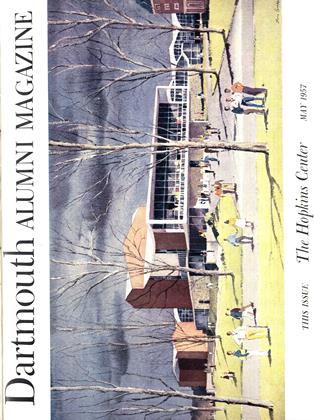DIRECTOR
IT was the conviction of President Emeritus Hopkins that a man's love and need for doing some kind of work with his hands is a part of his heritage, largely denied to him in these days of industrialization. Out of this conviction was born in 1941 a wood-working and metals-working shop for the students and faculty of the College.
The Student Workshop has been successful from the start, attracting from 600 to 800 students annually and developing to the point where the space on the third floor of Bissell Hall has long since become inadequate. In the Hopkins Center the new workshop, though still limited in space, will provide much more floor area and will assure better working conditions and room for more work benches, tool cabinets and storage. It will also make it possible to accommodate more students and, above all, to accommodate them with greater safety.
That there will be a great many more students taking advantage of the Student Workshop in the Hopkins Center seems a safe prediction. The better organization of equipment and work areas will attract them, and will encourage them to stay with projects long enough to do a good job. A greater variety of activities will be an attraction and will also induce students working in the shop to try their hands in new materials.
In addition to wood-working, which will continue to be an important part of the Workshop program, we plan, in our new Hopkins Center quarters, to enlarge our machine shop with equipment for handforging hot and cold-rolled steel and, possibly, for casting softer metals such as aluminum and bronze. Our present shop has very limited equipment for jewelry and silver-smithing, and the new shop plan is expected to encourage perhaps as many as 75 students every year to work in jewelry. With the help of a few faculty members who are interested in the project, we are now working on lapidary equipment that will make it possible to cut and polish stones from gem materials either purchased or collected on geology field trips. This equipment will cut anything from Cobachons from native stone to a carefully faceted diamond. A fine set of jewelry-making equipment left to the Workshop by Miss Dorothy Cleaveland will help to provide two complete jewelers' benches.
Nothing is being done in the field of ceramics at the present time. Plans for the new shop provide a room and equipment for a limited number of students, perhaps 100 each year. The ceramic shop will be immediately adjacent to the Sculpture Studio, thus allowing close cooperation between the two. Textiles is another field into which an enlarged Workshop program may have a chance to go.
The present Student Workshop is open Monday through Friday from 8 to is a.m. and from 1 to 5 p.m., with the afternoon as the general, busy period. Boys who work in the shop regularly and constructively are seldom or never in trouble of a disciplinary nature, which suggests that it would be a wise decision to make the Student Workshop and other shops and studios available at the times when trouble is most likely to develop. Therefore, with the opening of the new Hopkins Center we plan to have the Workshop facilities open on Friday night and Saturday afternoon and night.
There are many other physical improvements in the new shop that this brief article has not attempted to take up. They will all contribute to an enlarged and more satisfactory program for Dartmouth students. And this in turn will be an integral part of the larger Dartmouth program to develop the "whole man." In the Hopkins Center to an extent not possible with our present inadequate set-up in Bissell Hall we shall be able to offer the student an opportunity to work in the realm of reality to use the mind and hands coordinately - to develop skills that make it possible to achieve visible and satisfying results. Just to work with the hands and to develop skills is a great satisfaction; but the Workshop offers also the opportunity to think creatively and to attack a new problem constructively and positively, letting the mind direct the hand and the hand provide the skill toward the end of achieving a new and satisfying result. This is an experience quite new and unusual to many people in our modern society. It is a stabilizing influence in an unstable civilization.
Prof. Poling in the present Workshop
A CROSS-SECTION OF PART OF THE WEST SIDE OF THE CENTER, SHOWING STUDIOS AND WORKSHOPS
PROF. WALTER ROACHAssistant Director of The Players
PROF. EDGAR H. HUNTER JR. '38 Lecturer in Architectural Design
 View Full Issue
View Full Issue
More From This Issue
-
 Feature
FeatureExciting Theater Ahead
May 1957 By WARNER BENTLEY -
 Feature
Feature"An Open-Arms Aspect ..."
May 1957 By ANN HOPKINS POTTER -
 Feature
FeatureThe Man Who Designed the Center
May 1957 By ROBERT L. ALLEN '45 -
 Feature
FeatureDramatics
May 1957 By PROF. HENRY B. WILLIAMS -
 Feature
FeatureA New Dimension in Dartmouth Education
May 1957 -
 Feature
FeatureA Stimulus to Town Development
May 1957 By PROF. HUGH S. MORRISON '26,
Features
-
 Feature
FeatureREPORT CARD
NOVEMBER 1964 -
 Feature
FeatureOur Captivating Compendium
APRIL 1978 -
 Cover Story
Cover StoryPolice Chief Dean Esserman ’79 Restores Law and Order to the City of Providence
July/August 2005 By DIRK OLIN ’81 -
 Feature
FeatureSpiked Boots and the End of an Era
APRIL 1998 By Edie Clark -
 Feature
FeatureThe Wheelock Dream, Sparsely Realized, Is Still a Force in the Life of the College
OCTOBER 1965 By JOHN HURD '21 -
 Feature
FeatureNotebook
Jan/Feb 2012 By JOHN SHERMAN


